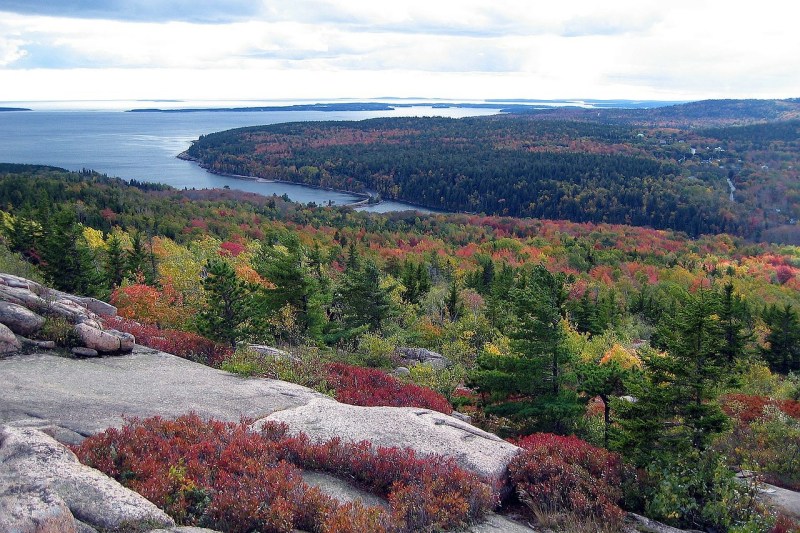Acadia National Park in Maine is one of the country’s most well-loved destinations for seeing fall foliage. The unique mix of coastal cliffs, forests, and mountains has much to offer leaf-peepers, and a lot of that is due to the diverse variety of tree species found in the area. Multiple kinds of maples, birches, and oaks create a vibrant mix of reds, oranges, and yellows that you won’t want to miss.
So, how do you make sure you catch it all this year? Here is everything you need to know about viewing Acadia National Park fall foliage.
How to time your trip to see peak foliage at Acadia National Park

Just like with the aurora borealis, peak fall foliage can be difficult to predict. That said, it’s not impossible, especially with the help of foliage trackers like the one from Maine.gov. We know we’re in for an amazing season if we have a warm, wet summer followed by a cool, sunny fall with little frost.
Generally, peak foliage in Acadia usually occurs in mid-October. You may see colors starting to change as early as late September or continuing into late October, but for most seasons, the second or third week of October provides the best chance. Of course, Mother Nature could have all sorts of plans, so pay attention to weather patterns.
How to avoid the crowds during Acadia’s peak fall season

Acadia National Park, which was first established as a National Monument in 1916, is one of the top 10 most visited national parks in the U.S. It sees around 4 million visitors annually. Because of that, the park can get crowded, especially during weekends in mid-October.
To help mitigate the crowds, park officials have implemented a reservation system between May and October. Remember to make your park reservation at Recreation.gov.
If you’re looking to avoid crowds, plan your visits around a convenient weekday, since weekends see the most traffic. Plan to arrive just after sunrise for the least amount of congestion or after 4 p.m., when most day-trippers and tour busses leave. Some areas might still have lingering crowds, but this can be a good time for scenic drives, shorter hikes, or catching sunsets at overlooks.
It’s important to book accommodations well in advance if you want to see the fall foliage. However, if options are limited, you might also find luck in towns that are a bit further away. Ellsworth, which is about a half-hour drive away, is a great alternative.
Top scenic spots for leaf-peeping at Acadia National Park

Now that you’ve planned your trip, where should you look to find the best views? Here are our top scenic spots.
Cadillac Mountain
Cadillac Mountain is the highest point on the Eastern Seaboard, so it’s no surprise that this is number one on our list. You’ll see a range of hues against the granite cliffs and the ocean. Visitors can hike to the summit via the Cadillac South Ridge Trail, which is 7 miles round-trip, or drive up the Cadillac Summit Road. If you plan to drive up, don’t forget to make a reservation. They’re required from late May to October. This area is a popular spot for sunrise and sunset views, but it’s definitely worth it.
Park Loop Road
Park Loop Road is a 27-mile scenic drive around Acadia National Park, and it’s one of the easiest ways to see fall foliage. It passes through many different elevation levels and has a bunch of scenic pullouts. This road also goes by many of Acadia’s top attractions, such as Sand Beach, Thunder Hole, and Otter Cliffs. If you want to cover a lot of ground without strenuous hiking, this is an excellent way to experience the park.
Jordan Pond
Jordan Pond is a must-see if you don’t mind an easy 3-mile loop hike. This pond is framed by twin mountains known as The Bubbles, and it has some of the best reflective views on the water. The path is relatively flat and is accessible to most visitors, but please take note that there is currently a road closure for a 0.3-mile section from the Jordan Pond Path to the Bubble Trail intersection.
Beehive Trail
If you’re an adventurer looking for a challenging hike, the Beehive Trail might just be the thing for you. It’s a short, 1.5-mile trail up some steep climbs, iron rungs, and narrow ledges. Needless to say, this hike isn’t for the faint of heart, but the views are incredibly rewarding. From the top of Beehive Trail, you’ll see expansive views of the surrounding forests and all the beauty they have to offer. For a less intense experience, the nearby Bowl Trail also provides similar views.
Acadia National Park has something to offer every fall foliage hunter. From beautiful drives to scenic hikes, you won’t be short of leaf-peeping opportunities if you time your stay right. Pay attention to foliage trackers and remember to create a reservation, and you’ll be well on your way to having the best fall foliage experience ever.




